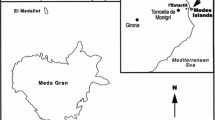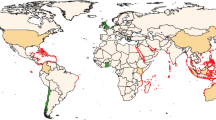Abstract
We estimated the economic value of changes in the quality of a coral reef ecosystem to SCUBA divers in the Caribbean using a stated preference mail survey. Our sampling frame was all divers with U.S. home addresses who purchased a tag required for diving in the Bonaire National Marine Park in 2001. Divers were asked how they might have altered their trip choice had the quality of the coral reef system been different from what they experienced. From these responses we inferred the value of three different levels of quality defined by visibility, species diversity, and percent coral cover. We used random utility theory and mixed logit to analyze the choice questions. Our sample size was 211, and our survey response rate was 75%. For modest changes in quality we estimated per person annual losses at $45. For larger losses the value was $192.
Similar content being viewed by others
References
Adamowicz W, Boxall PC, Louviere JL, Swait J and Williams M (1999). State preference methods for valuing environmental amenities. In: Bateman, IJ and Willis, KG (eds) Valuing environmental preferences, Oxford Press, Oxford University
Allison GW, Lubchenco J and Carr MH (1998). Marine reserves are necessary but not sufficient for marine conservation. Ecol Appl 8(1S): S79–S92
Arin T and Kramer RA (2002). Divers’ willingness to pay to visit marine sanctuaries: an exploratory study. Ocean Coast Manage 45: 171–183
Champ P (2003). Collecting survey data for non-market valuation. In: Champ, P, Boyle, K and Brown, T (eds) A primer for nonmarket valuation, Kluwer Academic Publishers, London
Dillman DA (2007). Mail and internet surveys. Wiley, New York
Dixon JA, van’t Hof T and Scura LF (1993). Meeting ecological and economic goals: marine parks in the Caribbean. Ambio 22(203): 117–125
Dixon JA, Scura LF and van’t Hof T (2000). An economic and ecological analysis of the Bonaire Marine Park. In: Cesar, HSJ (eds) Collected essays on the economics of coral reefs, pp 242. Kalmar Sweden, Cordio
Hanemann WM (1999) Welfare analysis with discrete choice models. In: Herriges JA, Kling CA (eds) Valuing recreation and the environment: revealed preference methods in theory and practice
Holmes TP and Adamowicz WL (2003). Attribute-based methods. In: Champ, P, Boyle, K and Brown, T (eds) A primer for nonmarket valuation, pp. Kluwer Academic Publishers, London
Lindsey G and Holmes A (2002). Tourist support for marine protection in Nha Trang, Viet Nam. J Environ Plann Manage 45(4): 461–480
Louviere JJ, Hensher D and Swait J (2000). Stated choice methods: analysis and application. Cambridge University Press, Cambridge
Mathieu LF, Langford IH and Kenyon W (2003). Valuing marine parks in a developing county: a case study of the Seychelles. Environ Devel Econ 8: 373–390
Moberg F and Folke C (1999). Ecological goods and services of coral reef ecosystems. Ecol Econ 29: 215–233
Pendleton LH (1995). Valuing coral reef protection. Ocean Coast Manage 26(2): 119–131
Spash CL (2000). Assessing the benefits of improving coral reef biodiversity: the contingent valuation method. In: Cesar, HSJ (eds) Collected essays on the economics of coral reefs, pp 242. Kalmar, Cordio
Spurgeon JPG (1992). The economic valuation of coral reefs. Mar Pollut Bull 24(11): 529–536
Tongson E and Dygico M (2004). User fee system for marine ecotourism: the Tubbataha Reef experience. Coast Manage 32: 17–23
Train K (2003). Discrete choice methods with simulation. Cambridge University Press, Cambridge
Train K and Weeks M (2005). Discrete choice models in preference space and willingness to pay space. In: Alberini, A and Scarpa, R (eds) Applications of simulation methods in environmental resource economics, Springer & Dordrecht, Netherlands
Train K, Wilson W (2007) Estimation on stated-preference experiments constructed from revealed-preference choices. Transport Res B, forthcoming
Wielgus J, Chadwick-Furman N, Zeitouni N and Shechter M (2003). Effects of coral reef attribute damage on recreational welfare. Mar Res Econ 18: 225–237
Wilkinson C (2000). Status of coral reefs of the world: 2000. Australian Institute of Marine Science, Cape Ferguson Queensland
Author information
Authors and Affiliations
Corresponding author
Additional information
Presented at the 3rd World Congress of Environmental and Resource Economists in Kyoto, Japan, July 2006.
Rights and permissions
About this article
Cite this article
Parsons, G.R., Thur, S.M. Valuing Changes in the Quality of Coral Reef Ecosystems: A Stated Preference Study of SCUBA Diving in the Bonaire National Marine Park. Environ Resource Econ 40, 593–608 (2008). https://doi.org/10.1007/s10640-007-9171-y
Received:
Accepted:
Published:
Issue Date:
DOI: https://doi.org/10.1007/s10640-007-9171-y




